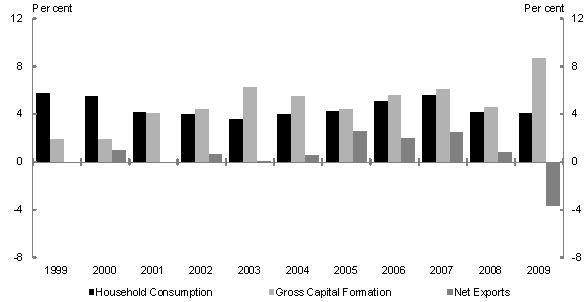The current economic framework served China well through the global financial crisis, although this episode is yet to reach its conclusion. We can see imbalances emerging in the Chinese economy reflecting, among other things, low interest rates, a low exchange rate, and a low wage share. There will be policy challenges in ensuring these imbalances do not derail growth.
There are three broad drivers of growth in the Chinese economy: consumption, investment, and net exports. The Central Government is committed to raising the consumption share of the economy. However, consumption is a relatively stable contributor to economic growth, and it will take many years for policy to raise the consumption share substantially. It will require reforms to raise household incomes, including social security and health reforms, and policies aimed at raising the wage and capital incomes of households. It will also require a reduction in the savings rate at a time when the aging of the population will raise the dependency ratio and increase incentives for households to save.
Net exports declined significantly as a contributor to growth during the global financial crisis (see Chart 8). In the short term, relative weakness in the major advanced economies will mean Chinese export growth will likely remain subdued. In the longer term, China recognises the need for domestic demand, rather than net exports, to make a larger contribution to growth if growth is to be sustainable.
Investment supported growth during the global financial crisis and will continue to be an important driver of growth in the short term. China faces a difficult balancing act as public investment seeks to continue to support growth while credit is being reined in to control inflation, with a dampening effect on private investment.
Chart 8: Consumption, investment, and net exports contributions GDP

Source: CEIC Data 1990-2011.
It appears likely that China will continue to have significant fiscal room to support the economy if necessary, although local government liabilities will be an area to watch. Local government NPLs could turn out to be large but should be manageable. Longer term, however, local governments will need a firmer financing basis that is less dependent on property sales and debt. Fiscal reform will need to address the revenue base of local governments and the system of Central-local government transfers.
As Chinese capital markets mature, there will be implications for the operation of monetary policy. China has ambitions for greater integration with global capital markets, but this will require the introduction of more market-based mechanisms for managing the financial sector. Interest rate liberalisation, relaxation of capital controls, and further exchange rate flexibility are all necessary steps towards greater capital market integration.
In a more liberalised financial sector, monetary policy based on attempts to regulate the supply of credit is less likely to be successful. In fact, the PBoC already has difficulty managing credit as banks resort to off-balance sheet financing vehicles to circumvent restrictions on bank credit. The use of market-based mechanisms, in particular movements in interest rates, will become more important tools of monetary policy in this environment.
The Chinese Government recognises the significant economic challenges faced by the Chinese economy and these are acknowledged in the 12th Five Year Plan. The Plan makes broad commitments to restructure the Chinese economy, with a continued focus on administrative measures. While there is some movement towards market-based policy solutions, such as expanding the use of RMB in cross-border trade and investment, with a stated aim of ultimately making the RMB convertible, reform in this direction remains gradual.